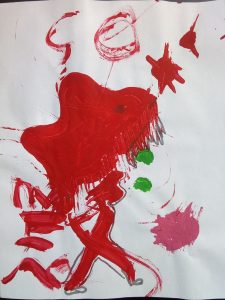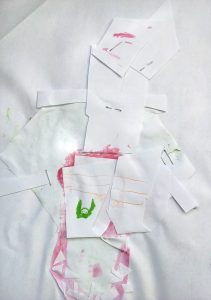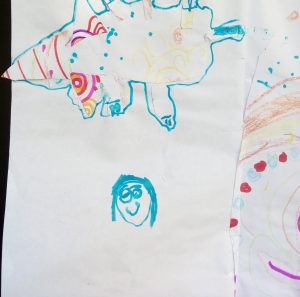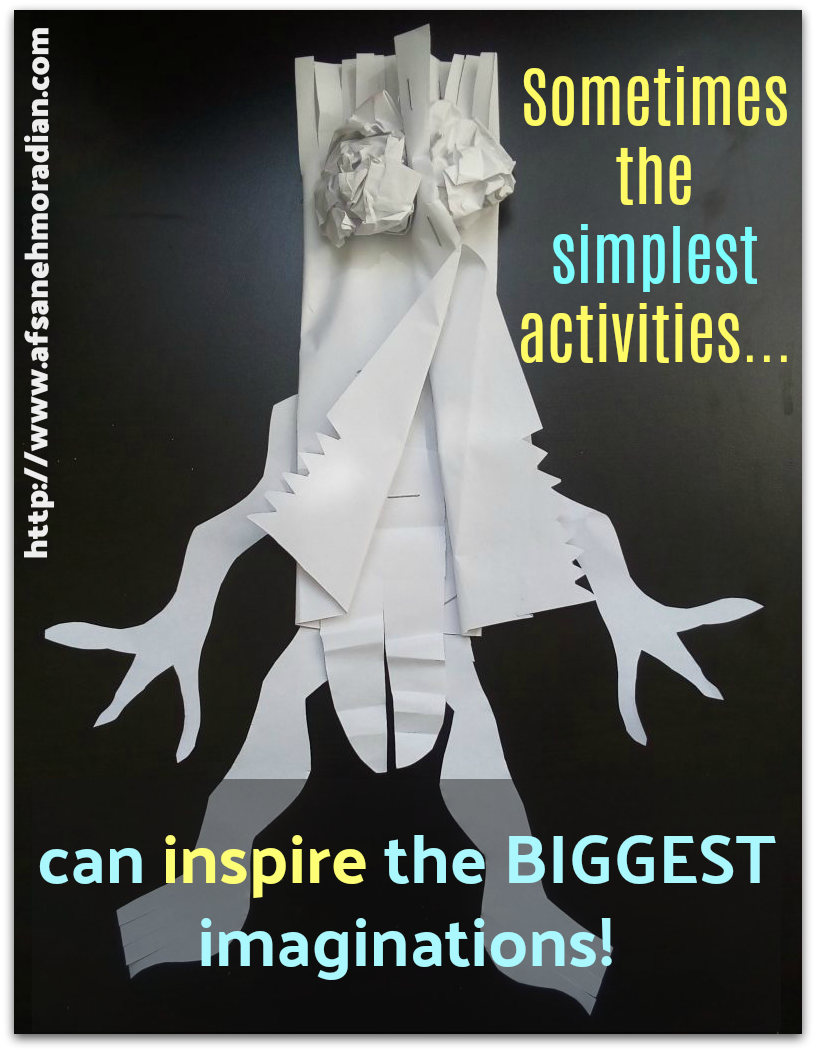
Like many other parents, I am constantly looking for interesting art projects for my daughter to try. Some have long material lists, some never quite come out even close to the example photo.
I’ve spent so much time looking and trying arts and crafts projects that I completely lost sight of how little children (and adults) actually need to be creative.
I accompanied my daughter to a workshop given by the Spanish illustrator Adolfo Serra at Centro de las Artes de San Agustin. It had not been the easiest day for me, having received my first rejection from an agent, no matter how pleasant and encouraging the message. The last thing I wanted to do was spend two hours in a kids’ art workshop.
I was surprised and impressed by how engaging the first activity was without involving anything more than basic art supplies: markers, two colors of paint, scissors, and white paper. We were all asked to make a mark, any kind we wanted, on a piece of paper and then stand and walk around the table. When we were stopped, we sat in a different seat and added more marks to the paper in front of us. We did this variation on “musical art” a few more times. The last time, we were asked to look carefully at the paper before us and “see” a monster within the blotches of paint and marker before us.

I was instantly reminded of the therapeutic nature of art when I outlined a red monster, it’s head ending in a line of red paint drips and named my monster: Decapitated Writer in Search of an Agent Monster.
My mood lifted and I was having fun. I became aware of how simple the activity had been and how fun this would be in any art room with several kids.
The second activity was the greatest reminder that kids and adults, apparently, don’t need endless art supplies to be creative or produce exciting work.
We were given three pieces of white paper, scissors, staples, glue, and tape. The assignment was to create a monster using only these materials. We were encouraged to give the monster as much volume as possible.
Everyone set to work and kids as young as 5 were focused on constructing their monsters for close to an hour. I was blown away by the variety of monsters and the complexity of their structures.

My daughter cut pieces of paper and stapled and glued them to one sheet of paper. She decided to ignore the no color rule, and gave her monster a life vest with her face on the side.
Others created monsters from geometric shapes such as a cube and cylinder. I used a prism base to create a tree-like monster with snowball eyes. Other monsters resembled a scorpion or a character from a future Tim Burton film.

The literacy of art
To close each activity, we placed our work on the floor and took turns explaining our work: the monster’s name, where it lives, what it eats. Each time, my daughter said her monsters eat “parents who behave badly.” I guess I’m supposed to take that as a hint.
As each child presented their work, the interdisciplinary teacher in me started imagining how easily (and inexpensively) classes could make their own monsters out of white paper and then write character profiles, and even short stories inspired by their creations. WIth the monster already made and stories written, students could then create shadow boxes or dioramas representing one scene from the story.
The challenge for me now as an educator and parent is to simplify my thinking in order to provide kids with the maximum opportunity for creativity through the most basic of materials.
One more thing…
Through color-coding in stores, kids “learn” which toys are “supposed” to be for girls or boy. Pink and yellow toys are considered “girly” and anything blue or dark green is obviously for boys, right? What about the toys themselves? Can boys play with dolls and girls play with trucks?
Of course, they can! And that’s the open-minded thinking that is captured in my children’s picture book, Jamie is Jamie.
I wrote Jamie is Jamie for my daughter who’d been told that only boys can play a superhero. My daughter and every other child deserve a book that gives them permission to be free to play and explore their own way-not the way everyone “thinks they should.”
I created my book to challenge gender stereotypes and encourages children to make play choices based on their interests. And because playing is fundamental to learning, I’ve created a special section in Jamie is Jamie for teachers, parents, and caregivers where they can find tips on how to make kids’ playtime learning time.
Get the scoop on Jamie is Jamie on Amazon or FreeSpiritPress.com

Afsaneh has been teaching for over 15 years from preschool to graduate school, and is often invited to give teacher training workshops and speak at educational conferences. Her vast experience in working with different ages, academic levels, and cultures has given her the ability to work with anyone and help them achieve their learning goals. She is also the author of Jamie is Jamie.



Leave a Reply